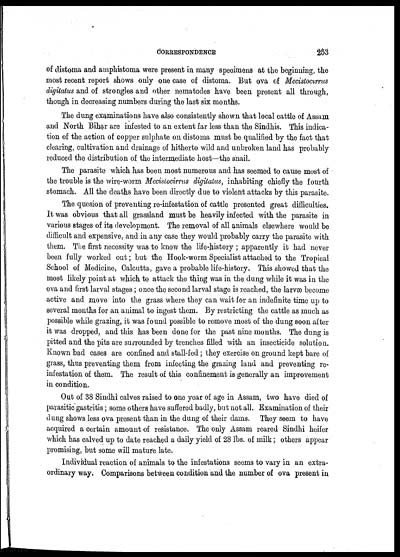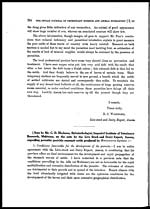Medicine - Veterinary > Veterinary colleges and laboratories > Indian journal of veterinary science and animal husbandry > Volume 1, 1931 > Part III (September 1931) > Correspondence
(300) Page 253
Download files
Individual page:
Thumbnail gallery: Grid view | List view

CORRESPONDENCE 253
of distoma and amphistoma were present in many specimens at the beginning, the
most recent report shows only one case of distoma. But ova of Mecistocirrus
digitatus and of strongles and other nematodes have been present all through,
though in decreasing numbers during the last six months.
The dung examinations have also consistently shown that local cattle of Assam
and North Bihar are infested to an extent far less than the Sindhis. This indica-
tion of the action of copper sulphate on distoma must be qualified by the fact that
clearing, cultivation and drainage of hitherto wild and unbroken land has probably
reduced the distribution of the intermediate host—the snail.
The parasite which has been most numerous and has seemed to cause most of
the trouble is the wire-worm Mecislocirrus digitatus, inhabiting chiefly the fourth
stomach. All the deaths have been directly due to violent attacks by this parasite.
The quesion of preventing re-infestation of cattle presented great difficulties.
It was obvious that all grassland must be heavily infected with the parasite in
various stages of its development. The removal of all animals elsewhere would be
difficult and expensive, and in any case they would probably carry the parasite with
them. The first necessity was to know the life-history ; apparently it had never
been fully worked out; but the Hook-worm Specialist attached to the Tropical
School of Medicine, Calcutta, gave a probable life-history. This showed that the
most likely point at which to attack the thing was in the dung while it was in the
ova and first larval stages; once the second larval stage is reached, the larvæ become
active and move into the grass where they can wait for an indefinite time up to
several months for an animal to ingest them. By restricting the cattle as much as
possible while grazing, it was found possible to remove most of the dung soon after
it was dropped, and this has been done for the past nine months. The dung is
pitted and the pits are surrounded by trenches filled with an insecticide solution.
Known bad cases are confined and stall-fed; they exercise on ground kept bare of
grass, thus preventing them from infecting the grazing land and preventing re-
infestation of them. The result of this confinement is generally an improvement
in condition.
Out of 38 Sindhi calves raised to one year of age in Assam, two have died of
parasitic gastritis; some others have suffered badly, but not all. Examination of their
dung shows less ova present than in the dung of their dams. They seem to have
acquired a certain amount of resistance. The only Assam reared Sindhi heifer
which has calved up to date reached a daily yield of 28 lbs. of milk; others appear
promising, but some will mature late.
Individual reaction of animals to the infestations seems to vary in an extra-
ordinary way. Comparisons between condition and the number of ova present in
Set display mode to: Large image | Zoom image | Transcription
Images and transcriptions on this page, including medium image downloads, may be used under the Creative Commons Attribution 4.0 International Licence unless otherwise stated. ![]()
| Permanent URL | https://digital.nls.uk/75226695 |
|---|
| Description | Covers articles from 1931. |
|---|




